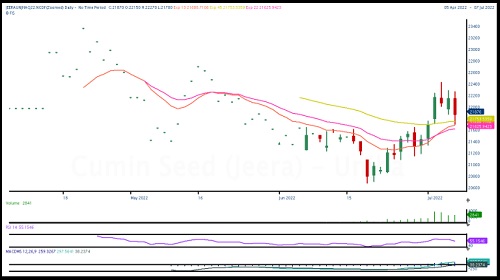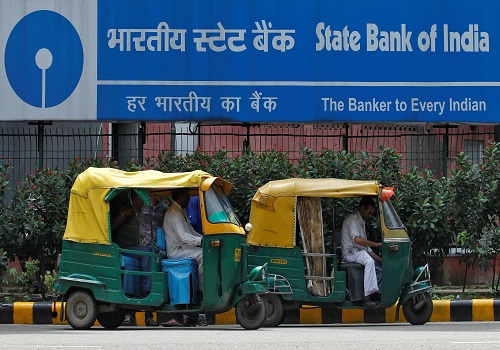Agri Commodity Technical Report 11 July 2022 - Geojit Financial Services

Follow us Now on Telegram ! Get daily 10 - 12 important updates on Business, Finance and Investment. Join our Telegram Channel
SPICES
• Spices complex ended Thursday’s session in red on NCDEX. Jeera and turmeric futures lost more than one per cent, while dhaniya ended over 0.5 per cent down.
• The export of spices from India during 2021-22 declined nearly 13 per cent on year to 1,531,154 ton, according to data from the Spices Board India. In terms of value, exports dipped by about 1.25 per cent to 3,057,644.24 rupees. Export of chilli, turmeric, jeera, coriander, fenugreek declined, while that of pepper, cardamom, ginger and fennel rose.
• India exported 153,154 ton of turmeric in in FY 2021-22, down 16.70% on year. Coriander exports were down 15.16% on year at 48,658-ton, data showed.
• The exports of jeera during declined 27.28% on year to 216,996 ton. Export of small cardamom jumped by 63 per cent to 10,572 ton year on, while that of pepper rose 9.5 per cent.
• The export of spices from India during Apr-Dec declined 7.5% on year to 1.2 mln tn, according to data from the Spices Board India. In terms of value, exports rose marginally to 230.7 bln rupees. Sluggish demand for chilli, jeera, turmeric, coriander and fenugreek weighed on exports.
• The exports of jeera during Apr-Dec declined 24.5% on year to 173,796 tn, from 230,120 tn a year ago.
• India exported 116,408 tn of turmeric in Apr-Dec, down 20.6% on year. Coriander exports were down 12.8% on year at 37,566 tn, data showed.
• Exports of small cardamom rose 68.3% on year to 7,337 tn. The huge rise was also seen in ginger exports, which rose 57.5% on year at 130,091 tn.
• Exports of chilli in Apr-Dec were down 7.6% on year at 435,725 tn, while mint product exports were at 21,386 tn, up 4.8% on year, according to the data.
• According to the second advance estimates by Gujarat state agriculture department, jeera production is seen declining to 236980 tons in 2021-22, down 41 per cent year on year. Area is seen at 289000 ha as against 473800 ha a year ago. Coriander production is seen declining as well to 211680 tons compared to 221240 tons in 2020-21.
• Government sees 2020-21 coriander output at 720000 tons compared to 701000 tons a year ago.
• Government sees 2020-21 turmeric output at 1.11 million tonnes compared to 1.15 million tons a year ago.
• Output of small cardamom is seen rising by 100% on year to 22520 tons according to the Spices Board.

COTTON
• UK-based Cotton Outlook has revised downward its estimate for global cotton production in 2022-23 (Aug-Jul) by 108,000 tn to 26.3 mln tn, the agency said in a report. The revision has been made as production in the US is expected to be lower due to severe drought, which is likely to affect the yield. Production in the US is seen at 3.5 mln tn, compared with 3.6 mln tn projected in May. Production of cotton in India and China is seen steady at 6.0 mln tn and 5.8 mln tn, respectively. The agency has also lowered its estimate for global consumption in 2022-23 by 755,000 tn to 25.2 mln tn due to fall in demand from most major consuming countries.
• The area under cotton across the country in the 2022-23 (Jul-Jun) season was over 6.4 mln ha as of Friday, up 3.8% from a year ago, data from the farm ministry showed.
• The Cotton Association of India has revised downward its production estimate for the 2021-22 (Oct-Sep) marketing season to 31.5 mln bales (1 bale = 170 kg), from 32.4 mln bales projected a month ago, it said in a release. The cut in estimate can be attributed to some crop loss because of excess rains in November in the key producing states that hit quality of the crop. Of the total crop, 28.8 mln bales had arrived in markets across India till May. Estimate for exports in the current marketing year has been maintained at 4.0 mln bales. India shipped around 3.8 mln bales of cotton till May, the association said.The association has also lowered its estimate for domestic cotton consumption to 31.5 mln bales, while imports for the season are pegged at 1.5 mln bales. The ending stock for the 2021-22 season has now been estimated at 4.7 mln bales, as against 5.4 mln bales projected a month ago, the release said.
• The area under cotton in northern parts of India, mainly in key producers Haryana and Punjab, is expected to decline in the 2022-23(Jul-Jun) season, according to back-of-the-envelope calculation based on government data from state farm departments.
• The US Department of Agriculture has raised its estimate for global cotton production to 121.3 mln bales (1 US bale = 218 kg) for 2022-23 (Aug-Jul), from 121.1 mln bales projected a month ago. The increase in estimate is attributed to rise in production in Egypt and West Africa, the agency said in its World Agricultural Supply and Demand Estimates report for June. Global cotton consumption is seen lower at 121.5 mln bales in 2022-23, compared with 121.9 mln bales a month ago, due to fall in demand from Mexico, Bangladesh, and Vietnam. Global exports are estimated at 47.5 mln bales, as against 47.6 mln bales a month ago. The agency has maintained its 2022-23 global ending stocks estimate at 82.8 mln bales. For India, the agency has maintained its estimate for production and domestic consumption for 2022-23 at 27.5 mln bales and 25.5 mln bales, respectively. Exports for the coming season are seen at 4.0 mln bales. Cotton ending stock in India is seen at 7.5 mln bales for 2022-23, marginally lower from 7.6 mln bales projected a month ago. The average price for US upland cotton during 2022-23 season is seen at 95 cents per pound, up by 5 cents from the previous month.
• Global cotton production for 2022-23 (Aug-Jul) is seen at 26.13 mln tn, around 1% higher compared to ongoing season, the International Cotton Advisory Committee has said in a report. The increase in production is led by a 25% rise in Pakistan's cotton production. Cotton production in the US is estimated at 3.6 mln tn in the coming season, as against 3.8 mln tn in 2021-22. The fall in production is attributed to lower acreage and unfavourable weather. The National Weather Service in the US is currently reporting the West Texas area as being in the "exceptional drought" category, it said. Global cotton area in 2022-23 season is estimated to decline by 1% on year to 32.8 mln ha. Area under cotton in the US is seen declining by 11%, followed by 5% in Australia and 1% in Brazil. Elsewhere, India is once again the global leader in area followed by the US, China, Pakistan and Brazil. "The high price of fertilisers and the high cost of fuel is undoubtedly influencing planting decisions all over the globe.The committee sees global consumption a tad lower at 26.09 mln tn in 2022-23. Global production is currently projected to outpace consumption, putting downward pressure on prices and potentially stabilising the volatility in prices. However, the production surplus is marginal and could likely change as the season matures. If production falls significantly below consumption, prices are very likely to remain elevated and the volatility will continue.
• The committee sees global exports for the 2022-23 season at around 10.03 mln tn, as against 10.09 mln tn in 2021- 22. Global ending stocks are estimated at 20.38 mln tn, slightly higher than 20.34 mln tn in 2021-22.
• India's cotton imports have gathered pace after the government exempted customs duty on the commodity on Apr 13. Indian traders and mills have bought 400,000-500,000 bales (1 bale = 170 kg) of cotton after the duty removal, trade officials said.
• India's cotton acreage in 2022-23 (Jul-Jun) is expected to rise 9% on year to 13.2 mln ha, as per the median of the estimates of 10 prominent players in the cotton value chain polled by Informist.
• Stakeholders in the textile industry have urged the government to extend duty-free cotton imports till Dec 31 to boost textile exports and help address the dearth of raw material in the market.
• India's cotton output in the 2021-22 (Oct-Sep) marketing year is seen at 36.2 mln bales (1 bale = 170 kg), as per the median of estimates of 13 prominent players in the cotton value chain polled by Informist

OTHERS
• As per official sources, National Agricultural Cooperative Marketing Federation of India Ltd. (NAFED) has procured 24,18,016 MT Chana as of 9th June, 2022. The States where procurement has been done are: Gujarat (558,642 MT, procurement closed), Maharashtra (NAFED-6,62,484 MT, procurement closed & FCI72,466 MT), Madhya Pradesh (8,05,000 MT), Rajasthan (1,60,586 MT), Karnataka (73,867 MT, procurement closed), Andhra Pradesh (71,353 MT) and UP (13,618 MT). Chana procurement is being done at the MSP of INR 5,230 per quintal. Total procurement target is 29 lakh MT.
• According to the recent report by Australian Bureau of Agricultural and Resource Economics and Sciences (ABARES), Chickpea sowing area in the country is estimated to decrease to mere 4,43,000 hectare, down by 28% from 616,000 hectares while production is likely to fall by 43% to 606,000 MT from 1.062 MMT this year.
• Latest data by Australia Bureau of Statistics reveals that Chickpea export from Australia has increased marginally to 31,499 MT, up by 3.67% in April from 30,383 MT previous month. However, total volume of export during the Marketing Year has reduced by 38% to mere 3,50,951 MT compared to same period last year. Bangladesh emerged as a major buyer for Chickpea with buying 15,941 MT followed by Nepal (4,933 MT) and United Arab Emirates (2,418 MT).
• The Securities and Exchange Board of India has asked the National Commodity and Derivatives Exchange to not launch any new chana contracts on its platform till further notice, the market regulator said in a release on August 16, 2021.
• India’s guar gum exports increased in the month of May’2022 by 36.42% to 27,748 MT compared to 18,971 MT during previous month. However, the gum shipments were up by 46.27 % in May’2022 compared to the same period last year. Out of the total exported quantity, around 8541 MT (30.78%) bought by US, Russia bought 4,686 MT (16.89%), China 3,618 MT (13.04%), Germany 3,408 MT (12.28%). Export demand was driven by bullish crude oil prices. We expect Guar export in June’22 at 25,000-28,000 tonnes.
• India’s Guar split exports increased in the month of May’2022 by 731% to 5,347 MT as compared to 643 MT previous month. However, the guar split shipments down by 50.66% in May’22 compared to the same period last year at 10,838 MT. Out of the total exports, around 3,800 MT (71.07%) bought by China, US 860 MT (16.08%), We expect guar split export in June at 4,000-5,000 tonnes. Total guar exports in May’22 recorded up by 6% to 33,095 MT as compared to 31,178 MT previous year same period amid bullish crude oil prices and increase in oil rig count. However, cumulative exports till May’22 still up by 12% to 200284 MT as compared to previous year same period at 179386.
• According to ANRPC, the global supply of natural rubber (NR) has further improved to 991,000 tons in May 2022 and resulted to a lower supply shortage to 198,000 tons with global demand estimated at 1.189 million tons during the same reference period.

OILSEED
• Farmers have sown soybean across 3.05 mln ha this kharif season as of Friday, up 0.8% from a year ago, the latest data from the farm ministry showed.
• India's exports of oilmeals rose 12% on year to 255,453 tn in May, according to data released by The Solvent Extractors' Association of India. During the first two months of the financial year that began on Apr 1, exports of oilmeals rose 11% on year to 589,425 tn. The rise in exports of oilmeals was mainly attributed to the surge in exports of mustard meal, which spiked to 398,355 tn in Apr-May from 274,392 tn in the year-ago period. However, in case of soymeal, exports remained subdued as "India is out priced in the international market. Exports of soymeal plunged to 43,899 tn in Apr-May compared with 92,139 tn a year ago. During Apr-May, South Korea imported 216,739 tn oilmeals from India, compared with 179,115 tn a year ago, and Vietnam imported 125,597 tn against 85,636 tn a year ago, the association said.
• India's vegetable oil imports in May fell 15% on year to 1.1 mln tn, The Solvent Extractors' Association of India said. The fall in imports was primarily due to supply constraints in the wake of the Russia-Ukraine geopolitical tension. However, the imports are likely to improve in the near term, with Indonesia lifting the export ban on palm oil from May 23. During Nov-May, imports of vegetable oil were at 7.8 mln tn, as against 7.7 mln tn a year ago. The vegetable oil basket consists of edible and non-edible oils. Edible oil imports were at 1.0 mln tn in May, against 1.2 mln tn a year ago. However, for Nov-May, these imports were at 7.55 mln tn, as against 7.48 mln tn in the year-ago period. In May, about 409,027 tn of crude palm oil was imported, against 755,633 tn during the same month last year. As of Jun 1, about 484,000 tn of edible oil was at ports, against 570,000 tn a year ago, while 1.8 mln tn was in the pipeline, against 1.4 mln tn during the same period last year.
• The US Department of Agriculture in its June report has projected global oilseed output for 2022-23 (May-Apr) to fall marginally to 646.8 mln tn from 647.2 mln tn estimated the previous month. The agency attributed the fall in output to projection of lower sunflower seed crop in Ukraine. However, soybean production estimate has been raised for Ukraine based on reports of progress of planting, while mustard seed output has been raised for Australia on the back of higher harvested area, both of which cushioned a sharp fall in global production outlook. The agency has projected global soybean output to rise by 680,000 tn to 395.4 mln tn. Brazil's 2022-23 soybean crop is estimated at a record 149 mln tn, and Argentina's crop is seen at 51 mln tn, unchanged from the May estimates. The agency has scaled up its estimate for global ending stocks for 2022-23 to 100.5 mln tn, up from 99.6 mln tn estimated in May.Estimate for global soyoil production for 2022-23 has also been revised upwards to 61.5 mln tn from 61.4 mln tn projected in the previous month.
• The department projected global soymeal output for 2022-23 at 256.9 mln tn, up from 256.5 mln tn last month. The estimate for global exports of soymeal in 2022-23 is higher at 70.1 mln tn, compared with 69.8 mln tn projected in May, it said. Soymeal is a derivative of soybean, manufactured by crushing the oilseed, and is mainly used in producing poultry feed.
• India's soymeal exports in May fell 13% on year to 40,000 tn, the Soybean Processors Association of India. For Oct-May, soymeal exports plunged to 550,000 tn from 1.79 mln tn in the year-ago period. In May, production of soymeal rose to 559,000 tn from 479,000 tn a year ago, while the output for Oct-May was at 4.23 mln tn, down from 5.99 mln tn in the year-ago period. Soybean arrivals in spot markets totalled 400,000 tn in May, up from 225,000 tn a year ago. However, for Oct-May, arrivals declined to 7 mln tn from 7.98 mln tn in the year-ago period. By the end of May, mills, traders, and farmers were left with around 6.2 mln tn of soybean stock. Crushing is now expected to be at 8 mln tn, against the previous estimate of 8.8 mln tn, while local meal consumption is projected at 5.4 mln tn, down from 5.6 mln tn earlier. Import of soymeal is projected at 700,000 tn, up from the earlier estimate of 400,000 tn.
• The government has allowed import of 2 mln tn of crude soyoil and crude sunflower oil per year each at nil duty under the tariff rate quota, the finance ministry said in a release. Imports made against the tariff rate quota will be effective from Wednesday till Mar 31, 2024.
• The Centre has extended stockholding limits on edible oils and oilseeds by six months till Dec 31 in a bid to check hoarding and check prices of the commodities in domestic markets, a government release said. In February, the Centre had imposed stockholding limits till Jun 30.
• India's mustard seed production in the crop year 2021-22 (Jul-Jun) is seen 29% higher at an all-time high of 10.95 mln tn, the Central Organisation for Oil Industry & Trade said in a release. In the previous year, mustard seed production was at 8.5 mln tn, according to the release. The area under has been pegged at 8.7 mln ha, and the average yield is estimated at 1.3 tn per ha.
• With the shortage of edible oil supply from imports due to the crisis in Ukraine, the Soybean Processors Association of India has recommended measures to augment the supply and cool down prices. The agency estimates a shortfall of edible oil supply from imports due to the war of approximately 200,000 tn a month of sunflower oil, it said in a note.
• The National Commodity & Derivatives Exchange will launch future contracts in refined castor oil on Mar 21, the bourse said in a circular. According to the contract specification the commodity will have trading unit of 2 tn, with the maximum order size of 200 tn. The contract will be settled in cash. The open interest threshold level to attract concentration margin in the commodity will be 17,900 tn.
• The government cut agriculture cess on crude palm oil and extended the lower customs duty on edible oils by six months till Sep 30 to cool domestic prices. The government cut Agriculture Infrastructure and Development Cess on crude palm oil to 5.0% from 7.5%, a finance ministry notification said. The Centre had in October slashed import duty on key edible oils till Mar 31. This has now been extended till Sep 30, the notification said.
• Farmers have sown mustard across 9.16 mln ha in the country, up 25.3% on year, in the ongoing 2021-22 (Jul-Jun) rabi season as of Friday, according to the farm ministry's data. The government fixed the minimum support price of the crop at 5,050 rupees per 100 kg for the 2022-23 (Apr-Mar) marketing season, as against 4,650 rupees in the previous year.
• The Solvent Extractors' Association has urged the Centre and the Securities and Exchange Board of India to resume futures trade in mustard seed on the National Commodity and Derivatives Exchange.
• The Solvent Extractors' Association has urged the government to exempt soyoil from genetically-modified labelling requirement as it may lead to a rise in prices, it said in a letter. Last year, according to reports, the Centre had asked states to enforce separate labelling for genetically-modified soyoil to help consumers make informed decision. • The government has reduced the basic import duty on refined, bleached, and deodorised palm oil, to cool domestic prices, the finance ministry said in a notification. The new duty rates will be in place till Mar 31, the ministry said. The effective basic import duty on refined, bleached, and deodorised palm oil has been reduced to 12.5% from 17.5% earlier. With the new duty cut, the duty difference between crude palm oil, which is a raw material, and refined, bleached, and deodorised palm oil, which is the finished product, has reduced to 5.5% from 11.0% earlier.
• The Securities and Exchange Board of India asked exchanges not to launch new contracts of some farm commodities, including those of soybean and its derivatives, and crude palm oil. The restrictions come into effect immediately and shall be applicable for one year.
• The Central Organisation for Oil Industry and Trade has estimated India's mustard output in the 2021-22 (Jul-Jun) rabi season at 10-11 mln tn because of increase in acreage, it said in a release. In 2020-21 the country produced around 8.5 mln tn of mustard, which is a crucial oilseed sown in the rabi season during Sep-Oct and harvested from February.
• India's soybean acreage in the 2021-22 (Jul-Jun) kharif season remained unchanged at 12.2 mln ha, agri ministry.
• India's castor seed production estimate for 2021-22 (Jul-Jun) has been revised down to 1.69 mln tn from 1.75 mln tn estimated in April, according to a survey conducted by the Solvent Extractors' Association through a private agency.
• Malaysia's crude palm oil output declined marginally on month to 1.5 mln tn in May, according to data from the Malaysian Palm Oil Board. Exports of palm oil in May rose 26.7% on month to 1.4 mln tn, while outbound shipments of biodiesel rose sharply by 98% on month to 46,345 tn. The total palm oil stocks in the country were down 7.4% on month to 1.5 mln tn as of May 31.
• Malaysia's palm oil exports for June are estimated to have fallen 7.4% from the previous month to 1,230,997 metric tons, cargo surveyor SGS (Malaysia) said.
To Read Complete Report & Disclaimer Click Here
For More Geojit Financial Services Ltd Disclaimer https://www.geojit.com/disclaimer
SEBI Registration Number: INH200000345
Views express by all participants are for information & academic purpose only. Kindly read disclaimer before referring below views. Click Here For Disclaimer












 320-x-100_uti_gold.jpg" alt="Advertisement">
320-x-100_uti_gold.jpg" alt="Advertisement">












